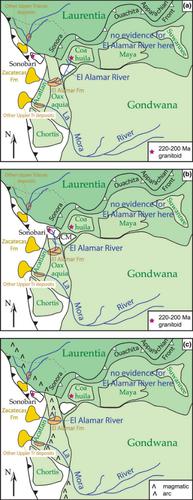当前位置:
X-MOL 学术
›
Basin Res.
›
论文详情
Our official English website, www.x-mol.net, welcomes your
feedback! (Note: you will need to create a separate account there.)
Provenance and maximum depositional ages of Upper Triassic and Jurassic sandstone, north-eastern Mexico
Basin Research ( IF 2.8 ) Pub Date : 2022-01-02 , DOI: 10.1111/bre.12654 Aaron J. Martin 1 , Mireia Domènech 1 , Daniel F. Stockli 2 , David Gómez‐Gras 3
Basin Research ( IF 2.8 ) Pub Date : 2022-01-02 , DOI: 10.1111/bre.12654 Aaron J. Martin 1 , Mireia Domènech 1 , Daniel F. Stockli 2 , David Gómez‐Gras 3
Affiliation

|
Upper Triassic to lowest Upper Jurassic strata in north-eastern Mexico record surface processes during the early rifting that led to the opening of the Gulf of Mexico. Exposed near Ciudad Victoria, Tamaulipas and northwest to Galeana, Nuevo Leon, these continental deposits are called the Huizachal Group. Several key questions about these strata hamper their integration into a regional understanding of Late Triassic and Jurassic sediment routing and deposition. First, the depositional age of the stratigraphically lowest unit, the El Alamar Formation, is less well established than the depositional ages of the stratigraphically higher parts of the succession, leading to questions about the timinig of the onset of tectonic context, and regional correlation of these strata. Second, better knowledge of provenance and sediment routing, including fluvial transport distance, can help determine whether and when the depositional basin was split into subbasins versus connected by a throughgoing river system. This study uses sandstone detrital zircon U-Pb isotopic ages and clast compositions to constrain depositional ages and reconstruct tectonic setting and provenance. Detrital zircon U-Pb ages yielded a maximum depositional age of 210 Ma for the part of the El Alamar Formation exposed near Galeana, younger than previously determined. Although long-distance (>100 km) sediment transport cannot be ruled out, the sources for Huizachal Group sandstone framework grains and detrital zircon could have been entirely local, within about 100 km. Alluvial deposits and pyroclastic and lava flows likewise indicate transport of no more than 100 km. We therefore infer deposition in partitioned rift basins receiving sediment from local sources. These data and interpretations contribute to understanding surface processes during the initial rifting that eventually led to opening of the Gulf of Mexico.
中文翻译:

墨西哥东北部上三叠统和侏罗统砂岩的物源和最大沉积年龄
墨西哥东北部的上三叠统到最低的上侏罗统地层在导致墨西哥湾开放的早期裂谷过程中记录了地表过程。这些大陆性矿床位于维多利亚城、塔毛利帕斯州和西北部新莱昂州加莱亚纳附近,被称为惠扎查尔群。关于这些地层的几个关键问题阻碍了它们融入对晚三叠世和侏罗纪沉积物路线和沉积的区域理解。首先,地层最低单元 El Alamar 组的沉积年龄不如层序中地层较高部分的沉积年龄确定,这导致了关于构造背景开始时间的问题和区域相关性的问题。这些地层。其次,更好地了解物源和沉积物路线,包括河流运输距离在内,可以帮助确定沉积盆地是否以及何时分裂为子盆地,还是由贯穿的河流系统连接。本研究利用砂岩碎屑锆石 U-Pb 同位素年龄和碎屑成分来约束沉积年龄并重建构造背景和物源。碎屑锆石 U-Pb 年龄在 Galeana 附近暴露的 El Alamar 组部分的最大沉积年龄为 210 Ma,比先前确定的要年轻。虽然不能排除长距离(>100 公里)的泥沙输送,但惠扎查尔群砂岩骨架颗粒和碎屑锆石的来源可能完全是局部的,大约在 100 公里以内。冲积沉积物、火山碎屑和熔岩流同样表明运输不超过 100 公里。因此,我们推断在从当地来源接收沉积物的分区裂谷盆地中的沉积。这些数据和解释有助于了解最终导致墨西哥湾开放的初始裂谷过程中的地表过程。
更新日期:2022-01-02
中文翻译:

墨西哥东北部上三叠统和侏罗统砂岩的物源和最大沉积年龄
墨西哥东北部的上三叠统到最低的上侏罗统地层在导致墨西哥湾开放的早期裂谷过程中记录了地表过程。这些大陆性矿床位于维多利亚城、塔毛利帕斯州和西北部新莱昂州加莱亚纳附近,被称为惠扎查尔群。关于这些地层的几个关键问题阻碍了它们融入对晚三叠世和侏罗纪沉积物路线和沉积的区域理解。首先,地层最低单元 El Alamar 组的沉积年龄不如层序中地层较高部分的沉积年龄确定,这导致了关于构造背景开始时间的问题和区域相关性的问题。这些地层。其次,更好地了解物源和沉积物路线,包括河流运输距离在内,可以帮助确定沉积盆地是否以及何时分裂为子盆地,还是由贯穿的河流系统连接。本研究利用砂岩碎屑锆石 U-Pb 同位素年龄和碎屑成分来约束沉积年龄并重建构造背景和物源。碎屑锆石 U-Pb 年龄在 Galeana 附近暴露的 El Alamar 组部分的最大沉积年龄为 210 Ma,比先前确定的要年轻。虽然不能排除长距离(>100 公里)的泥沙输送,但惠扎查尔群砂岩骨架颗粒和碎屑锆石的来源可能完全是局部的,大约在 100 公里以内。冲积沉积物、火山碎屑和熔岩流同样表明运输不超过 100 公里。因此,我们推断在从当地来源接收沉积物的分区裂谷盆地中的沉积。这些数据和解释有助于了解最终导致墨西哥湾开放的初始裂谷过程中的地表过程。











































 京公网安备 11010802027423号
京公网安备 11010802027423号